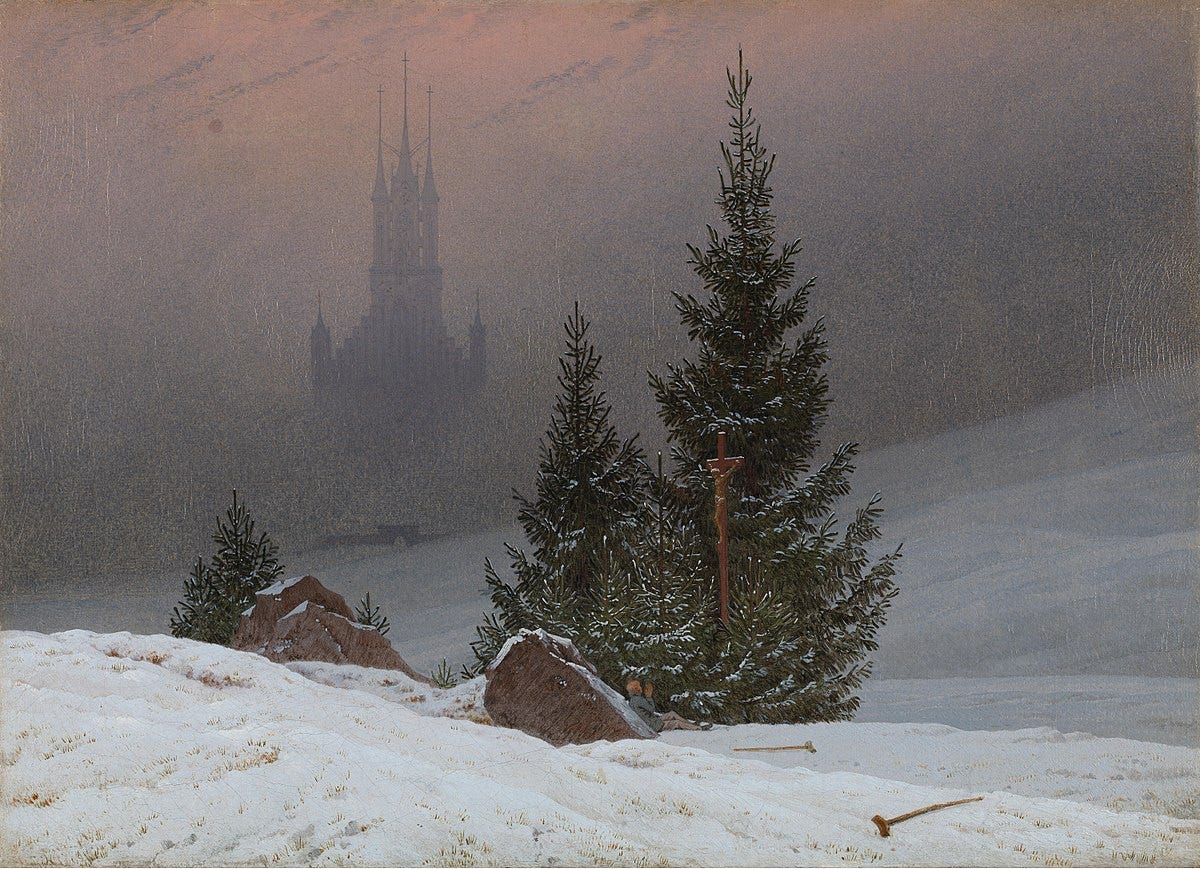Caspar David Friedrich | The most Romantic landscape
Who was Caspar David Friedrich and what's the difference between romantic with an 'r' and Romantic with an 'R'?
What do you feel while looking at this painting?
But really, what emotions are running through you as you look at it?
Serenity?
Fear?
Awe?
Melancholy?
Maybe nothing and maybe all of it.
Are you merely an on-looker uninvolved with the scene or do you see yourself inside the painting, like that man sitting by a rock? How would your feelings change if you were to put yourself in his shoes?
So many questions, but I find it crucial to think about this before I start explaining, because everything about this painting and about Caspar David Friedrich revolves around emotions.
Friedrich, the sixth of ten children of a German candlemaker, was one of the fundamental representatives of the Romantic movement. While Romanticism is notoriously hard to define with specific terminology, as it takes many shapes and forms, let's say the key idea is the victory of subjectivity over objectivity, the focus on the inner, emotional side of man, rather than the cold, rational one.
This radical rejection of rationality in favour of the spiritual, the interior, and the emotional was a response to the Enlightenment. On one hand, the scientific method and strict objectivity of the Enlightenment brought immense scientific progress and modernisation, but on the other, it destroyed the human soul — or at least, that's how the Romantics perceived it.
The individual became lost in the smoke of factory chimneys and crude machinery. And I don't mean this only in poetic terms — in the 18th century, in countries like England and Germany, vast areas of forests were cut down to fuel factory production and cities sprung up in the middle of the countryside, and so the pure, untouched nature, together with the purity of human soul, were crushed. As Jean-Jacques Rousseau, an icon for the Romantics, once wrote "Everything is good as it leaves the hands of the Author of things (God); everything degenerates in the hands of man," which couldn't be a more accurate description of the Romantic sentiment.
So how does this translate to painting?
Most importantly, nature becomes the protagonist, while the human is diminished. Landscapes are no longer just backdrops to human events in paintings, but they become independent carriers of emotion, meaning and symbolism.
Like in the Winter Landscape, the vast fields covered in snow and the tall fir trees dominate the scene. Half of the picture is taken over by the sky and by the thick mist that engulfs everything, revealing only hints of a Gothic cathedral in the back. The fog and the lighting create a particular mood, or atmosphere, that is not concerned with telling a story, but with provoking an emotional response in you. The landscape is the outward representation of the inner world of Friedrich and he uses it to make you feel that inner world too.
In fact, Friedrich painted landscapes exclusively and developed techniques to create specific moods within them. Here, for instance, he used only 3 pigments, focusing on the subtle gradation of tones that was essential to create an evocative scene. One of the pigments was smalt, a blue that was known for its transparent quality, which he consciously used in thin, translucent layers that created a misty effect as they overlapped.
So now we know why and how he created these moody scenes, but what are the emotions that he wished to transmit to us through this painting?
Friedrich was a religious man who put at the same level the greatness of God with the greatness of His creation, nature. Take the shape of the evergreen trees that mirrors the shape of the cathedral in the back, as it is illuminated by the weak morning sunlight that ever so slightly shines through the fog and the darkness. Sunshine becomes the symbol of hope, of the coming of better, brighter times that will save men from the uncertainty — fog and darkness — of the night. It is also sunlight that makes the cathedral visible, clearly pointing to the idea that this hope for salvation comes through God, or in general, through the divine.
The feeling of hope is further underlined by the green grass pushing through the snow, as well as by the man who has thrown away his crutches, visible in the foreground, symbolically throwing away his misery to look up at the cross with praying hands. He is small and insignificant before the cross and before nature and he is humbled by this overwhelming presence that can be both terrifying and fascinating at the same time.

This experience of complete awe but also fear is something the Romantics described as the Sublime - a concept that had only been used in Christian terminology before to define how we feel before God. And essentially, faith is centred around the understanding of truths that transcend reason and empirical experience. It's about feeling, and thus understanding that which is beyond us, that which we cannot explain, but can feel in our souls. And since Friedrich put nature on the same level as God, nature could evoke, through emotion, all that was not conceivable rationally.
The year 2020 was arguably the most intense year of this millenium and I thought it would be fitting to remind ourselves that the night is always followed by sunrise and that we always have hope that can carry us through the darkness. And even though 2021 wasn’t ideal either, we’re definitely bouncing back off from the bottom. Now that it’s fall and winter is slowly coming, I wish for all of us to find the same kind of peace and hope as expressed in this simple winter landscape.
If you like what you see, share it with a friend! Thanks for the support!





